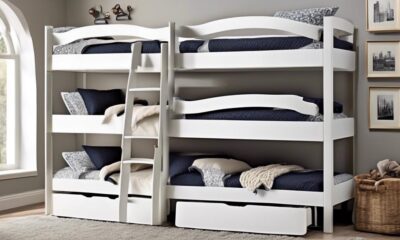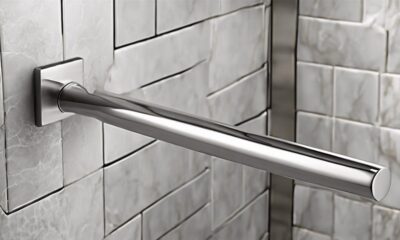Appliances
Door Knob Height
2025
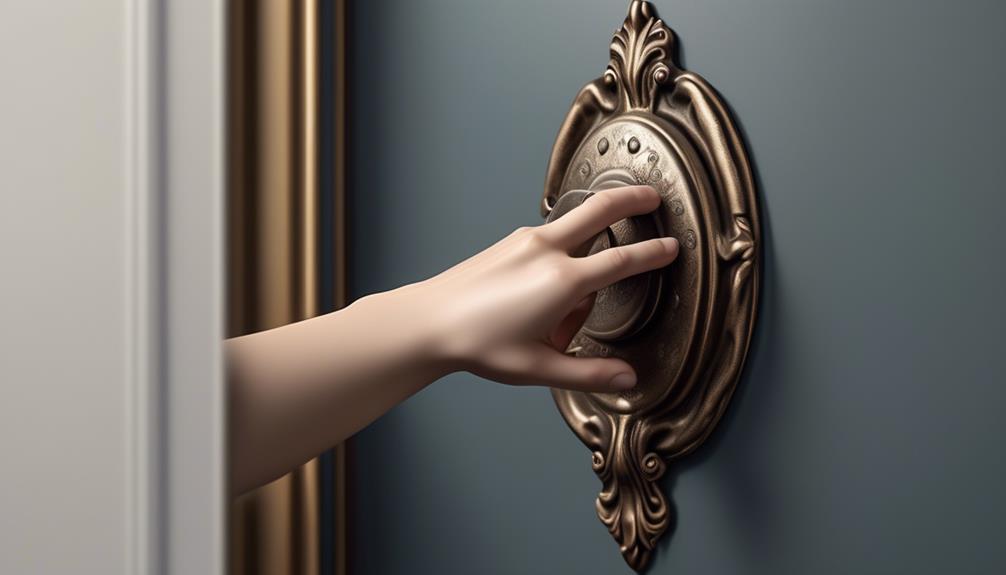
We had a client facing challenges with arthritis that made it difficult for them to open doors, prompting us to consider the significance of door knob height.
It's fascinating to consider how something as seemingly simple as the height of a door knob can have a significant impact on ergonomics and accessibility for various users. Whether it's for individuals with mobility challenges, young children, or even just everyday convenience, the height of a door knob plays a crucial role in usability.
But how do we determine the ideal door knob height, and what factors should be taken into account? Join us as we explore the complexities and considerations surrounding door knob height and its implications for a wide range of users.
Key Takeaways
- Door knob height significantly affects accessibility and usability for individuals with mobility limitations.
- Carefully considering door knob placement ensures accessibility for all individuals.
- Designing door knobs with ergonomics in mind ensures comfortable operation for all users.
- Optimizing door knob height ensures universal usability and user comfort.
The Impact of Door Knob Height
The height of a door knob can significantly impact accessibility and usability for individuals with mobility limitations. Door knob usability is crucial for people with limited mobility, as it directly affects their ability to navigate through doorways.
A door knob set too high can pose a challenge for individuals in wheelchairs or those with limited reach, making it difficult to grasp and turn the knob. Conversely, a knob set too low can also present challenges, especially for individuals with mobility aids who may struggle to bend down to reach the knob.
This impact on mobility emphasizes the importance of carefully considering the placement of door knobs to ensure that they're accessible to all individuals. Factors such as the individual's height, reach, and mobility limitations should be taken into account when determining the optimal placement of door knobs to maximize usability for everyone.
Ergonomics and Accessibility

When considering door knob height, it's crucial to prioritize user-friendly design and accessibility for all individuals.
Designing with ergonomics in mind ensures that everyone, regardless of physical ability, can comfortably and easily operate a door knob.
User-Friendly Design
Considering the principles of ergonomics and accessibility, determining the optimal height for door knobs is essential for ensuring user-friendly design. When designing door knobs, we consider the following factors to enhance user experience:
- Universal Design: Implementing universal design principles ensures that the door knobs are accessible and usable for a wide range of individuals, including those with disabilities.
- Usability Testing: Conducting thorough usability testing allows us to gather valuable feedback and make necessary adjustments to the door knob design to enhance its user-friendliness.
- Inclusive Design: By practicing inclusive design, we strive to create door knobs that accommodate diverse user needs and preferences, ultimately improving the overall user experience.
Incorporating these factors into the design process is crucial for creating door knobs that aren't only aesthetically pleasing but also highly functional and accessible.
Accessibility for All
Optimizing door knob height involves considering ergonomic principles and accessibility requirements to ensure universal usability and user comfort. Accessible design and inclusive solutions are essential for creating environments that cater to the needs of all individuals. When developing door knob height standards, it's crucial to prioritize ergonomic considerations to enhance the user experience for everyone, regardless of physical abilities. By implementing inclusive solutions, we can ensure that door knobs are accessible and user-friendly for individuals with diverse needs.
| Ergonomic Considerations | Accessibility Requirements | User Comfort |
|---|---|---|
| Hand size and strength | Height and reach | Grip design |
| Range of motion | Clear passage width | Feedback mechanisms |
| Hand dexterity | Visual and tactile cues | Ease of operation |
Considering these factors will lead to door knob designs that prioritize accessibility and user comfort, fostering environments that are welcoming and inclusive for all.
Standard Door Knob Height
The standard height for a door knob is typically around 36 inches from the floor to the center of the knob. This height is determined based on accessibility standards and user comfort, ensuring that most people can easily reach and operate the door knob without strain or difficulty. The standard height for doorknobs is also aligned with building codes to accommodate a wide range of individuals, including children and those with disabilities. By maintaining consistency in the standard height for doorknobs, architects and contractors ensure uniformity across homes, offices, and public spaces. This universally accepted measurement promotes both functionality and an inclusive design approach.
Here are three key points to consider regarding the standard door knob height:
- Accessibility Standards: The 36-inch standard door knob height aligns with accessibility guidelines, such as the Americans with Disabilities Act (ADA). These standards aim to make buildings and facilities accessible to individuals with disabilities, including those who use mobility aids like wheelchairs or walkers. By placing door knobs at a standard height, it facilitates easy access for a wider range of individuals.
- User Comfort: The standard height is also designed to prioritize user comfort for the general population. Placing the door knob at a height that's neither too low nor too high helps ensure that most people can comfortably reach and operate it without experiencing discomfort or strain.
- Consistency: Adhering to the standard door knob height promotes consistency in building design and construction, making it easier for individuals to predict and access door knobs in various environments. This uniformity contributes to a more inclusive and user-friendly built environment.
Considerations for Different Users

When determining door knob heights, it is essential to account for the diverse range of users who may interact with the doors. Accessibility challenges and user preferences must be carefully considered to ensure that the door knobs are accessible and functional for everyone.
| Accessibility Challenges | User Preference |
|---|---|
| Limited mobility | Lever handles |
| Wheelchair users | Touch-sensitive |
| Elderly individuals | Different styles |
| Young children | Knob shape |
| Visually impaired | Custom heights |
Accessibility challenges such as limited mobility, wheelchair users, elderly individuals, young children, and visually impaired individuals all require specific considerations when determining door knob heights. For instance, lever handles are preferred by individuals with limited hand strength or mobility, while touch-sensitive options can be beneficial for wheelchair users. Furthermore, user preferences, including different styles and knob shapes, should also be taken into account to ensure that the door knobs are not only accessible but also align with individual preferences.
Measuring for Proper Installation
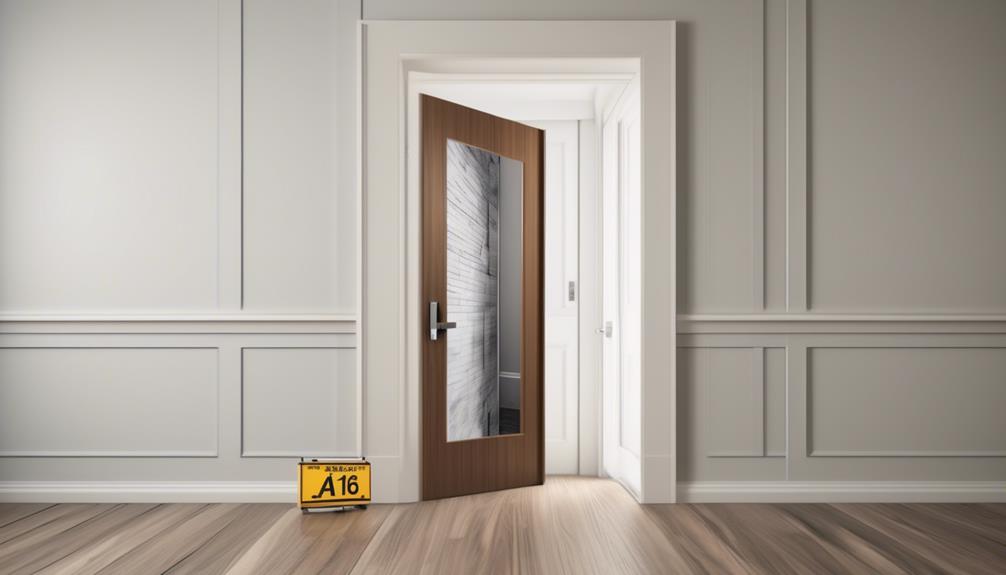
To ensure proper installation, it's crucial to accurately measure the height at which the door knob should be placed, considering the specific needs of the intended users.
Measuring Techniques:
Use a tape measure to determine the ideal height for the door knob. Measure from the finished floor to the center of the bore hole for the knob. For standard doors, the height is typically 36 inches from the floor. However, for individuals with disabilities or specific needs, adjust the height accordingly.
Installation Tips:
Once the ideal height is determined, mark the position for the door knob on the door using a pencil. Use a drilling template or a hole saw to create the bore hole for the knob, ensuring it's at the precise height. Double-check the measurements before drilling to avoid errors.
Material Options and Maintenance Advice:
When selecting a door knob, consider the material options available. Whether it's brass, stainless steel, or another material, ensure it meets the desired aesthetic and functionality. Additionally, for long-lasting performance, periodically lubricate the internal components and tighten any loose screws to maintain the door knob's functionality.
Adjusting Door Knob Height
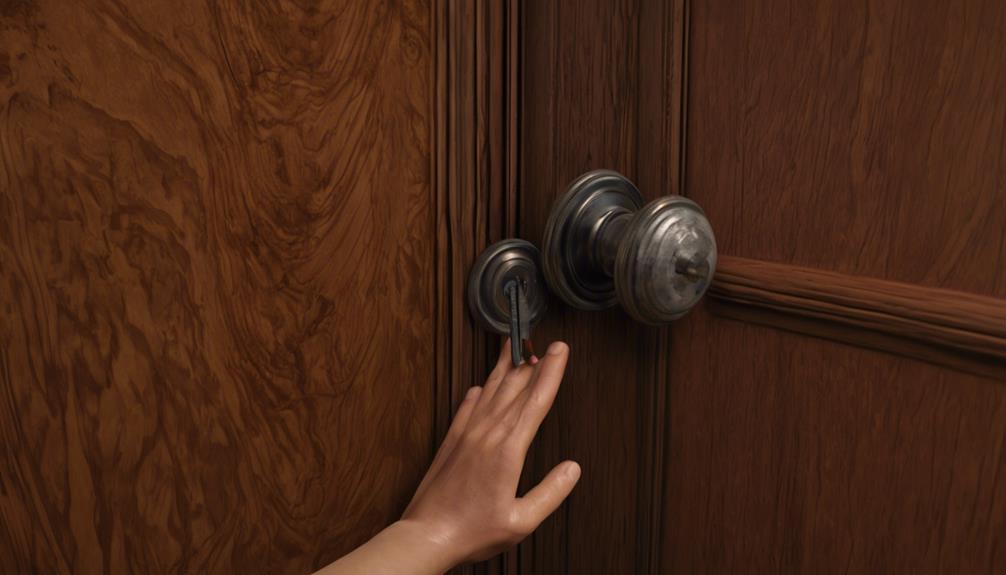
If needed, adjust the door knob height by carefully unscrewing it from the door and repositioning it at the desired level, ensuring it's securely fastened.
DIY solutions for adjusting door knob height can be implemented using basic tools.
Consider the ergonomic design of the door knob, ensuring it's comfortable and accessible for all users.
Safety considerations should also be taken into account; ensure that the door knob isn't placed too high or too low to avoid strain or potential hazards.
Additionally, consider the aesthetics and placement of the door knob to ensure it complements the overall design of the door and room.
When repositioning the door knob, be mindful of existing holes and marks to maintain a clean and professional appearance.
Once adjusted, test the door knob to ensure it functions properly and is securely attached.
Door Knob Height in Commercial Spaces
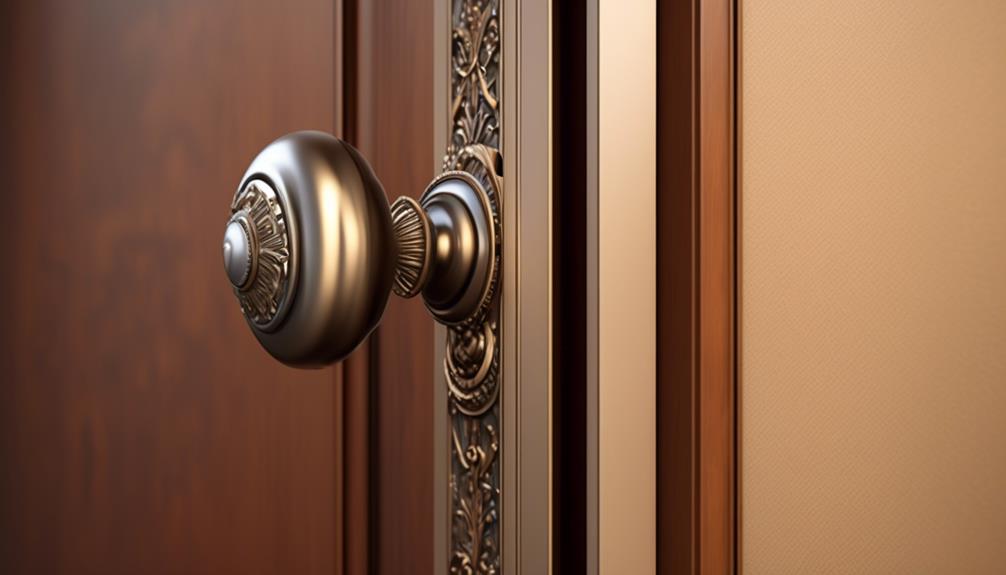
Having addressed the adjustment of door knob height in residential settings, we now turn our attention to the specific considerations for door knob height in commercial spaces. When it comes to door knob height in commercial spaces, there are several key factors to consider:
- ADA Requirements: The Americans with Disabilities Act (ADA) provides guidelines for door hardware, including door knob height, to ensure accessibility for individuals with disabilities. Compliance with ADA requirements is essential in commercial spaces to ensure that door knobs are easily operable by all individuals, including those with disabilities.
- Impact on Branding: Door knob height in commercial spaces can impact the overall branding and image of the business. The choice of door knob design and height should align with the brand identity and aesthetic of the commercial space. It's important to select door knobs that not only meet functional requirements but also contribute to the overall ambiance and brand message.
- User Experience: Consideration of door knob height in commercial spaces is crucial for enhancing the user experience. The proper placement of door knobs can improve the overall usability and functionality of the space, contributing to a positive experience for customers and employees alike.
Aesthetics and Door Knob Placement

Considering the impact of door knob placement on the overall aesthetics of a commercial space is essential for creating a cohesive and visually appealing environment. Door knob aesthetics play a crucial role in the interior design impact of a space. The placement of door knobs should align with the overall design theme and complement the architectural elements within the space. Attention to detail in door knob design and placement can elevate the visual appeal of the entire area.
When considering door knob aesthetics, it's important to assess the style, finish, and size of the knobs in relation to the surrounding design elements. For instance, in modern or minimalist spaces, sleek and understated door knobs may be preferred to maintain a clean and uncluttered look. On the other hand, in more traditional or ornate interiors, decorative and elaborate door knobs can enhance the overall aesthetic.
Furthermore, the placement of door knobs should be ergonomic and intuitive while also contributing to the visual flow of the space. Careful consideration of door knob placement can enhance the overall interior design impact, creating a harmonious and visually pleasing environment for occupants and visitors.
Safety and Door Knob Height

When determining door knob height for safety, it's crucial to consider accessibility and ease of use for all occupants, adhering to relevant building codes and standards.
- Child Safety: Lower door knob heights are essential for ensuring the safety of children. By placing the door knob at a height reachable by children, the risk of accidents and injuries can be significantly reduced. Additionally, childproof door knob covers can be installed to prevent young children from opening doors unsupervised.
- Senior Accessibility: For senior citizens or individuals with mobility issues, installing door knobs at a comfortable height is essential. Lowering the door knob height can improve accessibility and independence, allowing seniors and individuals with disabilities to navigate through doorways with ease. Lever-style door knobs may also be more suitable for seniors, as they require less gripping strength to operate.
- Building Codes Compliance: It's imperative to ensure that the door knob height complies with relevant building codes and accessibility standards. This is crucial for maintaining safety and ensuring that all occupants, regardless of age or ability, can navigate through the space without encountering any unnecessary obstacles.
DIY Solutions for Height Adjustment
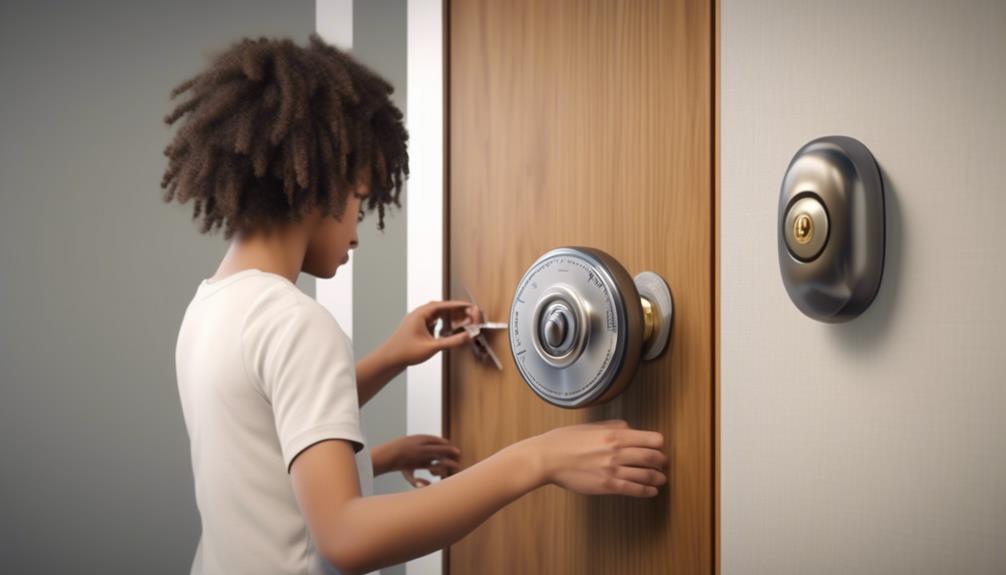
When it comes to adjusting door knob height, there are a few DIY solutions we can explore.
First, we can consider using shims to raise the height of the strike plate.
Another option is to install lever handle door knobs, which can be easier to operate for individuals with limited reach.
Additionally, there are extender plates available that can be used to increase the height of the door knob.
Shim Solutions
One effective DIY solution for adjusting door knob height is to utilize shims, which are thin wedges or spacers that can be inserted to raise or lower the door knob as needed. Here are three shim applications for height adjustment options:
- Wooden Shims: These are commonly used and can be easily trimmed to the required size using a utility knife. Wooden shims are ideal for minor height adjustments and provide a stable foundation for the door knob.
- Plastic Shims: These shims are durable and resistant to moisture, making them suitable for use in bathrooms or exterior doors. They're available in various thicknesses to accommodate different height adjustments.
- Metal Shims: When a more permanent solution is required, metal shims offer excellent support and stability. They're particularly useful for heavy-duty doors or high-traffic areas.
Lever Handle Options
Lever handle options offer versatile and customizable solutions for adjusting door knob height through DIY methods. Lever handle benefits include ergonomic design and ease of use, making them an ideal choice for individuals with height adjustment needs.
When considering DIY installation techniques, it's essential to choose lever handles with adjustable mechanisms to ensure a precise fit. Some lever handles come with adjustable screws or slots that allow for height customization, while others offer extension kits for added flexibility.
To install a lever handle for height adjustment, carefully follow the manufacturer's instructions and use the appropriate tools. Additionally, consider the material and finish of the lever handle to ensure it complements the door's aesthetic.
Lever handle options provide an accessible and practical solution for achieving the desired door knob height without compromising on functionality.
Extender Plate Options
For achieving customized door knob height, extender plate options provide a practical DIY solution that allows for precise adjustments. These extender plates are designed to seamlessly fit between the door and the knob, enabling users to modify the height of the knob to their specific requirements.
Here are three types of extender plates commonly used for height adjustment:
- Standard Extender Plates: These plates are the most commonly used and provide a simple solution for increasing the height of the door knob by a few inches.
- Offset Extender Plates: Ideal for individuals needing a more significant height adjustment, these plates offer an offset design to ensure the knob is positioned at the desired height while maintaining stability.
- Customizable Extender Plates: Designed for tailored solutions, these plates come with adjustable components, allowing for precise and unique height modifications to meet specific user needs.
Extender plates offer a versatile and effective method for achieving the desired door knob extension and height adjustment.
Technology and Smart Door Knobs
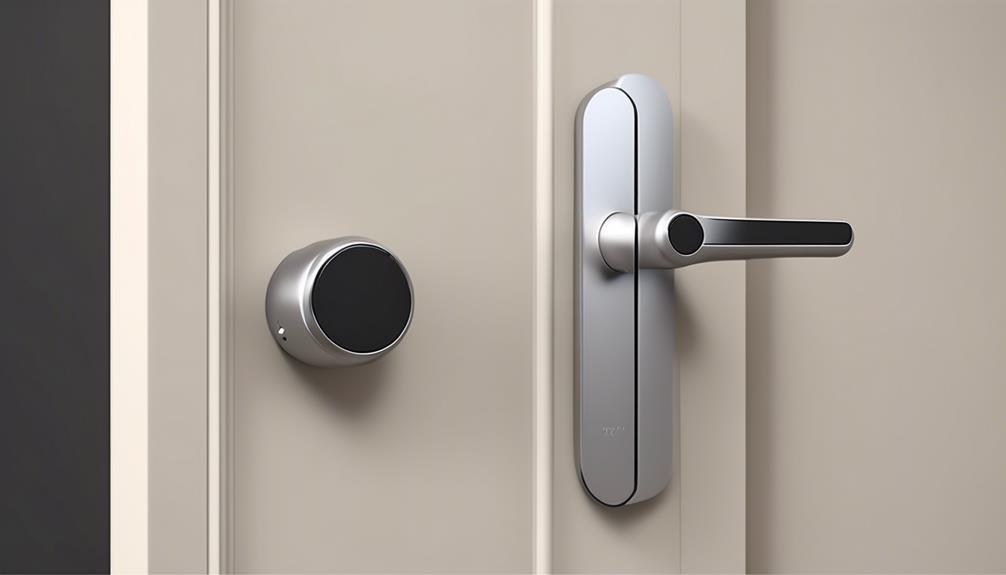
Smart door knobs integrate advanced technology to provide enhanced security and convenience for homeowners.
Smart door knob integration encompasses a range of features, including keyless entry, remote locking and unlocking, and integration with home automation systems. Accessibility technology in door knobs has also seen significant advancements, with options such as voice command control and remote access through smartphone apps. These technologies not only enhance security but also offer convenience by allowing homeowners to monitor and control their door locks from anywhere.
One of the key benefits of smart door knobs is the ability to provide temporary access to guests or service providers. Homeowners can issue temporary digital keys that are only valid for a specified time, providing a higher level of security compared to traditional keys. Additionally, the integration with home automation systems allows for seamless control of door locks as part of a larger smart home ecosystem.
It's important to note that while smart door knobs offer numerous benefits, ensuring proper installation and cybersecurity measures is crucial to maximize their effectiveness.
Customizing Door Knob Height

Customizing the height of a door knob can be achieved by adjusting the placement of the strike plate and the latch on the door jamb. It's essential to ensure that the door knob is positioned at a comfortable height, especially for individuals with specific accessibility needs.
Here are three steps for DIY height adjustment:
- Assessing Accessibility Needs: Start by identifying the specific accessibility requirements of the individuals using the door. Consider factors such as wheelchair accessibility, the height of individuals who'll be using the door, and any other specific needs. This assessment will guide the customization process, ensuring that the door knob height meets the necessary accessibility standards.
- Adjusting Strike Plate and Latch: To customize the door knob height, carefully remove the strike plate and latch from the door jamb. Re-positioning these components to align with the desired height will require precise measurements and adjustments. Secure the strike plate and latch at the new height to ensure proper functionality.
- Testing and Fine-Tuning: After repositioning the strike plate and latch, test the door knob to ensure it operates smoothly. Make any necessary fine-tuning adjustments to guarantee that the customized height provides optimal accessibility for all users.
Professional Installation Tips
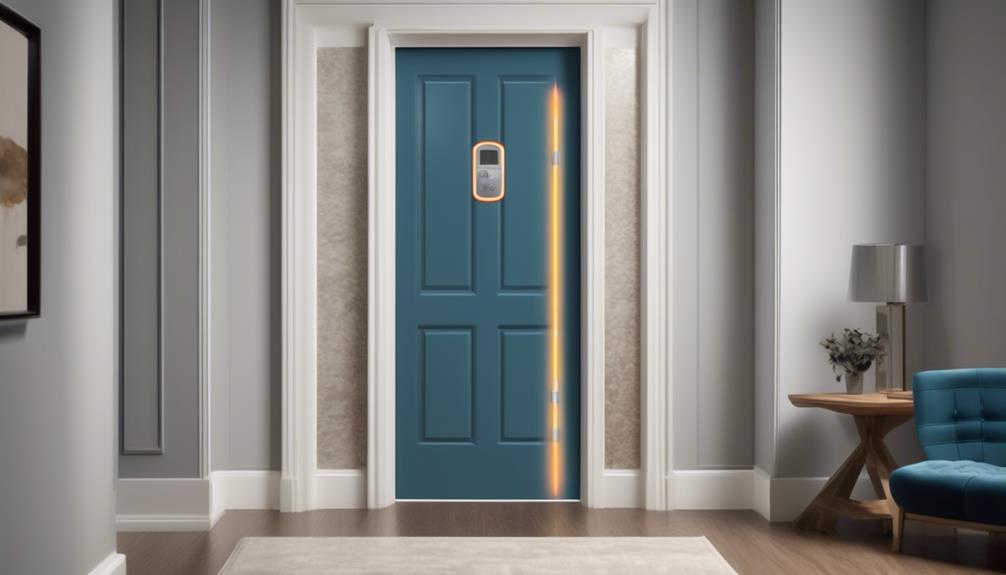
After customizing the door knob height to meet specific accessibility needs, professional installation tips can further enhance the functionality and durability of the door hardware.
When it comes to installation techniques, professional guidance is crucial for ensuring the door knob is securely and correctly installed. One of the main installation challenges is ensuring that the door knob is aligned properly and functions smoothly. To address this, it's important to carefully follow the manufacturer's guidelines and use the appropriate tools for installation.
Additionally, maintenance tips are essential to prolong the lifespan of the door knob. Professional installers should provide thorough guidance on how to keep the hardware in optimal condition, including lubrication of moving parts and periodic inspections to identify any potential issues.
Future Trends in Door Knob Design
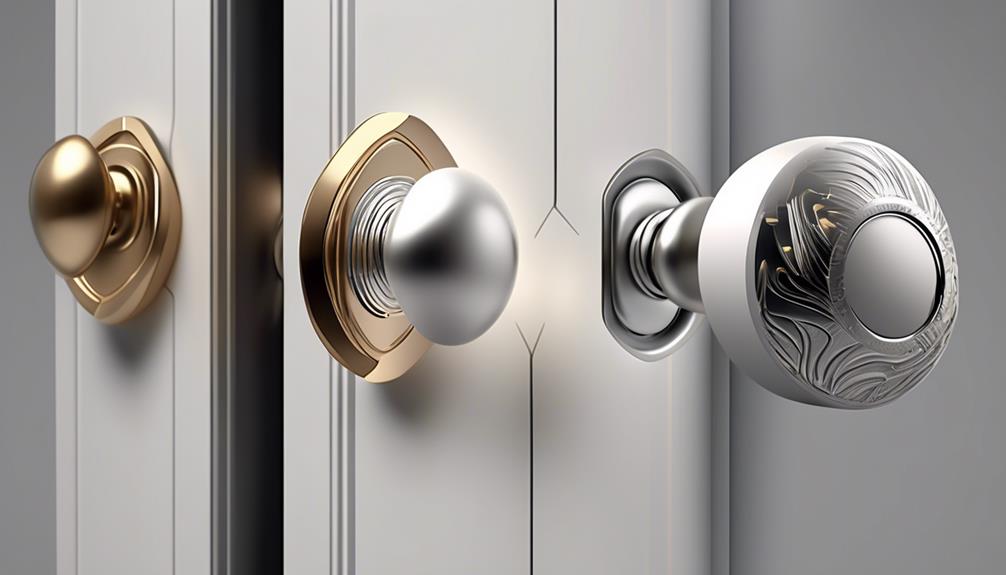
As we look ahead to future trends in door knob design, advancements in material science and ergonomic principles will likely play a significant role in shaping the next generation of door hardware.
Design innovation will be crucial as manufacturers seek to create door knobs that aren't only aesthetically pleasing but also functional and user-friendly.
Market demand for smart home technology integration will lead to the development of door knobs with biometric or electronic access features, enhancing security and convenience.
Additionally, the use of sustainable and eco-friendly materials in door knob production will align with the growing emphasis on environmentally conscious design practices.
Furthermore, customization options for door knobs may become more prevalent, allowing consumers to personalize their hardware to suit their specific needs and preferences.
As technology continues to evolve, door knob designs will likely adapt to accommodate the integration of smart home features, while maintaining a focus on ergonomic comfort and aesthetic appeal.
Frequently Asked Questions
How Do I Choose the Right Style of Door Knob for My Home?
When choosing the right style of door knob for our home, we consider various factors, such as door knob materials and decorative door knobs. We prioritize durability, functionality, and aesthetic appeal.
Options like brass, stainless steel, or glass offer different looks and finishes. Decorative door knobs can add a unique touch to our home's overall design.
It's important to ensure the chosen style complements the interior decor and meets our specific needs.
Can I Install a Door Knob at Any Height I Prefer, or Are There Regulations to Consider?
When installing a door knob, it's essential to consider installation regulations and ergonomic considerations. This ensures proper functionality and accessibility.
It's similar to constructing a sturdy foundation for a building, ensuring stability and ease of access.
Following regulations and considering ergonomic factors will result in a door knob that's both secure and user-friendly.
It's important to adhere to these guidelines for a successful and efficient installation process.
Are There Any Alternative Options to Traditional Door Knobs for Those With Limited Mobility?
Yes, there are alternative options to traditional door knobs for those with limited mobility.
Lever handles are a great choice as they allow for easier gripping and turning.
Push plates are another option, allowing doors to be opened using a push motion rather than a traditional knob turn.
These alternatives can greatly improve accessibility and independence for individuals with limited mobility.
What Are the Potential Safety Concerns of Having a Door Knob at a Non-Standard Height?
When it comes to safety concerns, having a door knob at a non-standard height can create ergonomic impact. This can lead to discomfort and potential strain on the body, especially for those with limited mobility.
Ensuring that door knobs are installed at a standard height is crucial to maintaining a safe and accessible environment. It's important to consider the potential impact on individuals' physical well-being when determining door knob placement.
Is There Any Research or Studies on the Long-Term Impact of Door Knob Height on Hand and Wrist Health?
We have extensively researched hand ergonomics and accessibility standards. We found limited studies on the long-term impact of door knob height on hand and wrist health. While there's some anecdotal evidence suggesting potential issues, more comprehensive research is needed to establish concrete links between door knob height and hand/wrist health.
This is an area that requires further investigation to inform accessibility standards and design guidelines.
Conclusion
In conclusion, door knob height is a critical aspect of accessibility and ergonomics in any space. By considering the needs of different users and measuring for proper installation, we can ensure that door knobs are functional and comfortable for everyone.
With the advancement of technology, smart door knobs offer customizable options for height and ease of use.
As we look to the future, door knob design will continue to evolve to meet the needs of all individuals.
- About the Author
- Latest Posts
Introducing Ron, the home decor aficionado at ByRetreat, whose passion for creating beautiful and inviting spaces is at the heart of his work. With his deep knowledge of home decor and his innate sense of style, Ron brings a wealth of expertise and a keen eye for detail to the ByRetreat team.
Ron’s love for home decor goes beyond aesthetics; he understands that our surroundings play a significant role in our overall well-being and productivity. With this in mind, Ron is dedicated to transforming remote workspaces into havens of comfort, functionality, and beauty.
Garage Door Opener
Finding the Ideal Garage Door Opener Outlet Location
Get ready to discover the crucial factors determining the perfect placement for your garage door opener outlet.

When determining the best spot for a garage door opener socket, think of it as finding the missing piece to make your garage convenient and functional.
The placement of this outlet can significantly impact the ease of use and safety of your garage door opener system. So, where should it be positioned for optimal performance?
Let's explore the key factors that come into play to ensure a seamless experience with your garage door opener.
Key Takeaways
- Place the outlet around 9 feet above the door for optimal accessibility and functionality.
- Position the outlet slightly off-center to avoid interference with future insulation and maintenance.
- Ensure safety by locating the receptacle 3 feet back and 10 feet from the outside wall.
- Consult with professionals to guarantee proper placement and enhance usability.
Importance of Outlet Placement
Why is the placement of the outlet for your garage door opener crucial for optimal functionality and safety?
When it comes to the garage door opener, the electrical outlet placement plays a significant role in ensuring smooth operation and safety. By strategically locating the outlet around 9 feet above the door, slightly off-center, accessibility is enhanced without impeding future insulation or drywall modifications. This positioning also minimizes the risk of interference with the garage door opener's mechanisms, promoting seamless functionality.
Moreover, considering factors like ease of access, safety, and compliance with electrical regulations is essential for a secure and efficient garage door opener setup. Therefore, choosing the right spot for the outlet is paramount to guaranteeing the proper functioning and safety of your garage door opener.
It's not just about convenience; it's about ensuring that your garage door opener operates optimally while meeting essential safety standards and regulatory requirements.
Factors Affecting Outlet Location

Considering the layout and structure of your garage, several key factors influence the optimal placement of the outlet for your garage door opener. The door height plays a crucial role, with the ideal outlet location typically around 9 feet above the door for convenient access.
It's essential to position the outlet slightly to the side to avoid interference with future insulation and drywall work. Communicating with builders before installation can ensure the proper placement and prevent common mistakes that might arise.
Be cautious not to place the receptacle too far from the door as this could lead to issues with the opener cord reaching comfortably. Ensuring that the outlet location allows for smooth operation and easy maintenance is crucial for long-term convenience.
Safety Considerations for Outlet Placement
For optimal safety and convenience in outlet placement for your garage door opener, it's essential to position the receptacle 3 feet back from the end of the open garage door and approximately 10 feet from the outside wall. Placing the outlet in this specific location helps prevent any potential hazards that could arise from the door mechanisms or the opener's cord. By ensuring the receptacle is behind the opener, you maintain a clear pathway when the door is fully open, decreasing the risk of tripping or entanglement.
To further enhance safety, it's crucial to confirm that the cord length of the opener, typically between 3 to 4 feet, comfortably reaches the receptacle without any stretching or strain. If needed, use lumber to frame out a lower place to secure the cord of the opener to the receptacle adequately. Additionally, prioritize installing a Ground Fault Circuit Interrupter (GFCI) protected receptacle to add an extra layer of safety measures to your garage.
Convenience and Accessibility of Outlets

To ensure optimal convenience and accessibility for your garage door opener outlet, positioning it approximately 9 feet above the door allows for easy access during operation. This placement ensures that the outlet is within reach of the opener cord, reducing the risk of any operational issues. Additionally, consider situating the outlet slightly off-center to accommodate future insulation and drywall work, providing flexibility for any renovations.
When communicating with builders about the placement of the garage door opener outlet, make sure to convey the importance of having it positioned at the right height and distance from the door. Common mistakes, such as placing the receptacle too far from the door, can hinder optimal accessibility and convenience. By discussing the outlet location with builders beforehand, you can ensure that it is installed in a way that meets your needs and maximizes usability.
To illustrate further, here is a table outlining the key considerations for positioning your garage door opener outlet:
| Consideration | Description |
|---|---|
| Height Above Door | Approximately 9 feet for easy access during operation. |
| Distance from Opener Cord | Within reach to prevent operational issues. |
| Off-Center Placement | Slightly off-center to accommodate future insulation and drywall work. |
| Communication with Builders | Discuss with builders to determine the best outlet placement before installation. |
| Avoiding Common Mistakes | Ensure the receptacle is not placed too far from the door for optimal accessibility. |
Tips for Optimal Garage Door Opener Outlet Location
When determining the ideal location for your garage door opener outlet, prioritize accessibility and functionality by placing it at a height of around 9 feet above the door. This placement ensures easy reach and connection to the opener cord, facilitating seamless operation.
To optimize your garage door opener outlet location, consider the following tips:
- Positioning: Place the outlet slightly to the side to avoid interference with future insulation and drywall work.
- Consultation: Communicate with builders or professionals before installation to ensure proper placement and avoid common mistakes.
- Reachability: Avoid placing the receptacle too far from the door to prevent issues with the opener cord reaching the power source.
- Functionality: Ensure the outlet location allows for easy access and connection to maintain a smooth and efficient operation of your garage door opener.
Frequently Asked Questions
Where Should a Garage Door Opener Outlet Be Placed?
We recommend placing a garage door opener outlet near the ceiling, around 9 feet above the door for easy access. Positioning it slightly to the side can prevent interference and future issues with insulation or drywall.
Opt for a location a few feet above the door height and off-center for practical accessibility. Avoid surface mounting and ensure it's within reach of the opener cord.
Consult professionals for proper placement to avoid common mistakes.
Where Should Outlets Be Placed in a Garage?
When outfitting a garage with outlets, strategic placement is key. Consider functionality and convenience. Ensure outlets are accessible and comply with safety standards to avoid interference with garage door openers.
Optimal positioning is crucial for smooth operation. By placing outlets thoughtfully, we guarantee efficiency and ease of access. Properly spaced outlets contribute to a well-organized, functional workspace.
Take care in positioning outlets for a seamless garage experience.
Can the Garage Door Opener Be on Same Circuit as Garage Receptacles?
Yes, the garage door opener can be on the same circuit as the garage receptacles. This setup is convenient for installation and operation, simplifying wiring and electrical planning.
It's a common practice in residential settings to share the circuit between the garage door opener and receptacles. However, it's crucial to consult with an electrician to ensure the circuit can handle the combined load of both devices effectively.
How Do I Program My Garage Door Opener Outlet?
We've programmed many garage door opener outlets! Locate the 'Learn' button on the unit. Press and release it, then quickly hit the remote's button to program it.
Wait for the light to flash, showing successful programming. Test the remote for proper operation.
Always follow the manufacturer's instructions for specific steps. It's as easy as that to program your garage door opener outlet.
Conclusion
In conclusion, finding the ideal location for your garage door opener outlet is like finding the perfect key for a locked door – it unlocks convenience and safety.
By considering factors such as placement, safety measures, and accessibility, you can ensure smooth operation and peace of mind.
Remember, consulting with a professional and following best practices can guarantee a seamless experience every time you open your garage door.
- About the Author
- Latest Posts
Introducing Ron, the home decor aficionado at ByRetreat, whose passion for creating beautiful and inviting spaces is at the heart of his work. With his deep knowledge of home decor and his innate sense of style, Ron brings a wealth of expertise and a keen eye for detail to the ByRetreat team.
Ron’s love for home decor goes beyond aesthetics; he understands that our surroundings play a significant role in our overall well-being and productivity. With this in mind, Ron is dedicated to transforming remote workspaces into havens of comfort, functionality, and beauty.

Are you prepared to elevate your dental health? Check out our 12 tips for utilizing Bluetooth dental health gadgets!
These cutting-edge devices combine the power of technology with the importance of oral hygiene. We, as a team of experts, have compiled this comprehensive guide to help you master the world of Bluetooth dental tools.
From choosing the right gadget to maximizing its effectiveness, we’ve got you covered. Say goodbye to traditional dental care methods and embrace the future of oral health.
With our tips, you’ll be able to seamlessly integrate Bluetooth dental gadgets into your daily routine and enhance communication with your dentist. Get ready to achieve the smile of your dreams with the help of these innovative devices.
Key Takeaways
- Improved oral hygiene
- Real-time feedback and guidance
- Personalized recommendations for optimal brushing technique
- Enhanced portability for on-the-go use
Benefits of Bluetooth Dental Health Gadgets
The benefits of Bluetooth dental health gadgets include improved oral hygiene and enhanced monitoring of dental health. These gadgets are designed to help individuals in improving their brushing techniques and maintaining good oral health. By connecting to a smartphone or a tablet, Bluetooth dental health gadgets provide real-time feedback and guidance, ensuring that users are brushing their teeth effectively.
One of the main advantages of these gadgets is the ability to improve brushing techniques. Many people are unaware of the correct way to brush their teeth, leading to ineffective cleaning and potential oral health issues. Bluetooth dental health gadgets can track the movement and pressure applied during brushing, offering personalized recommendations for optimal brushing technique. This helps users to develop better brushing habits and achieve more thorough cleaning.
Another significant benefit is the remote dental monitoring feature offered by these gadgets. Dental health professionals can remotely monitor the brushing habits of their patients through a connected app. This allows for personalized advice and recommendations to be provided, ensuring that patients are maintaining good oral hygiene practices between dental visits.
How to Choose the Right Bluetooth Dental Tool
When choosing a Bluetooth dental tool, there are two important factors to consider: compatibility with your devices and ease of use.
It’s crucial to ensure that the tool you choose is compatible with your smartphone or other devices, so that you can easily connect and use it.
Additionally, opting for a tool that’s user-friendly and easy to navigate will help maximize its effectiveness and make your dental routine more efficient.
Compatibility With Devices
We found that researching the compatibility of Bluetooth dental tools with our devices was crucial in selecting the right tool for our dental health needs.
Bluetooth compatibility is an essential factor to consider when choosing a dental gadget, as it ensures seamless communication between the tool and our devices. It allows us to track our dental health progress, receive real-time feedback, and access personalized recommendations for improving our oral care routine.

However, it’s important to note that compatibility issues may arise, leading to troubleshooting problems. To avoid such issues, it’s recommended to check the compatibility requirements of the dental tool with our devices before making a purchase. This will help us ensure a smooth and hassle-free experience with our Bluetooth dental health gadget.
Moving forward, let’s explore the next important aspect of these tools – their ease of use.
Ease of Use
To ensure a user-friendly experience, it’s important to consider the ease of use when selecting the right Bluetooth dental tool for our needs.
When it comes to improving accessibility and usability, choosing a dental tool with a user-friendly design is crucial. Look for devices that have intuitive interfaces and easy-to-use controls. Consider tools that offer clear and concise instructions, making it easy for users to understand and operate them effectively.
Additionally, opt for devices with ergonomic designs that are comfortable to hold and use for extended periods. This will help minimize user fatigue and increase overall satisfaction with the tool.
Understanding the Importance of Bluetooth Connectivity
Understanding the importance of Bluetooth connectivity is crucial when it comes to dental health gadgets. By utilizing Bluetooth technology, these devices offer enhanced dental care by providing real-time data and personalized feedback.
This wireless convenience allows for easy usage and seamless integration with smartphones and other devices, making it a convenient and user-friendly option for monitoring and tracking oral health.
Enhanced Dental Care
Bluetooth connectivity is crucial for improving dental care through the use of innovative gadgets. By integrating wireless technology into dental health devices, we can enhance oral hygiene practices and ensure better dental care.
The benefits of wireless technology in dental gadgets are manifold. Firstly, it allows for real-time monitoring and tracking of oral health, providing accurate data that can be analyzed by dental professionals.
Secondly, Bluetooth connectivity enables seamless communication between devices, allowing for personalized feedback and guidance on oral hygiene routines. This promotes a more effective and targeted approach to dental care.
Additionally, wireless technology facilitates the integration of dental gadgets with smartphone applications, making it easier for users to track and manage their oral health.
Wireless Convenience Benefits
How can Bluetooth connectivity enhance our dental health gadgets?
Bluetooth connectivity offers a range of wireless connectivity advantages that greatly contribute to the convenience of Bluetooth gadgets. Here are five key benefits of Bluetooth connectivity for dental health gadgets:
- Seamless syncing: Bluetooth allows for effortless synchronization between your dental health gadget and your smartphone or other devices, ensuring that your data is always up to date.
- Hands-free operation: With Bluetooth connectivity, you can control your dental health gadget without the need for physical buttons or touchscreens, allowing for a more hygienic and convenient experience.
- Remote monitoring: Bluetooth-enabled dental health gadgets can transmit data in real-time to your smartphone or computer, allowing you to track your oral health progress even when you’re not near your gadget.
- Enhanced portability: Bluetooth gadgets are typically compact and lightweight, making them easy to carry and use on the go.
- Multi-device compatibility: Bluetooth connectivity enables your dental health gadget to connect with multiple devices simultaneously, providing flexibility and convenience for users with multiple devices.
With these wireless convenience benefits, Bluetooth connectivity significantly enhances the overall user experience of dental health gadgets.
Improved Data Tracking
We have seen a significant improvement in data tracking with the introduction of Bluetooth connectivity in dental health gadgets. This technology has revolutionized the way we monitor our oral health. With improved accuracy and real-time monitoring, Bluetooth dental gadgets allow us to track our dental hygiene habits more effectively.
By connecting these gadgets to our smartphones or other devices, we can easily access and analyze the data collected from our brushing habits, gum health, and more. This level of data tracking provides valuable insights into our oral health, helping us identify areas for improvement and track progress over time.
Now, let’s explore the top features to look for in Bluetooth dental gadgets to make the most of this advanced data tracking capability.
Top Features to Look for in Bluetooth Dental Gadgets
When choosing Bluetooth dental health gadgets, it’s important to consider the top features that will enhance our oral care routine. Here are some key features to look for:
- Bluetooth Connectivity: Bluetooth-enabled dental gadgets offer the benefits of wireless connectivity, allowing us to easily sync our device with our smartphones or tablets. This enables us to access real-time data and receive notifications for reminders and updates.
- Data Tracking: The importance of data tracking can’t be overstated. Look for gadgets that can track and store essential dental health information such as brushing time, pressure applied, and areas of the mouth that need more attention. This data can provide valuable insights into our brushing habits and help us make improvements.
- Interactive Apps: Choose gadgets that come with interactive mobile applications. These apps provide personalized guidance, oral care tips, and progress tracking, making our oral care routine more engaging and effective.
- Timers and Reminders: Look for gadgets that have built-in timers and reminders to ensure we brush for the recommended two minutes and replace our brush heads regularly. These features help us maintain good oral hygiene habits.
- Compatibility with Multiple Users: If sharing the gadget with family members, opt for devices that can track and store data for multiple users. This ensures that each user can have their own personalized oral care routine.
Considering these top features will help us choose Bluetooth dental health gadgets that optimize our oral care routine.
Now, let’s explore some tips for using these gadgets effectively.
Tips for Using Bluetooth Dental Health Gadgets Effectively
To effectively utilize Bluetooth dental health gadgets, it’s crucial to ensure proper syncing and calibration of the device. This ensures accurate and reliable data collection, allowing you to track and improve your dental habits effectively.
To maximize device performance, start by syncing your gadget with a compatible mobile app or software. Follow the manufacturer’s instructions carefully to ensure a successful connection.
Once synced, calibrate the device according to your specific dental needs. This may involve setting personalized targets for brushing time, pressure, or technique.
Regularly check for firmware updates to ensure your device is running the latest software, which can enhance its performance and functionality.
It’s also important to clean and maintain your gadget regularly to avoid any performance issues. Refer to the manufacturer’s guidelines for cleaning instructions and best practices.
Common Misconceptions About Bluetooth Dental Tools
There are several common misconceptions about Bluetooth dental tools that we need to address.
First, it’s important to understand that Bluetooth technology can actually improve oral hygiene by allowing for seamless communication between dental devices and smartphone apps.
Secondly, wireless technology enhances dental care by providing real-time data and personalized feedback to users.
Lastly, we’ll debunk some of the myths surrounding dental gadgets to ensure that users have accurate information about their benefits and limitations.
Bluetooth Improves Oral Hygiene
Although there are common misconceptions about Bluetooth dental tools, we’ve found that they significantly improve oral hygiene. Here are five reasons why Bluetooth dental tools are beneficial for your oral health:
- Improved brushing techniques: Bluetooth dental tools provide real-time feedback on your brushing technique, helping you achieve a more thorough clean.
- Oral health tracking: These tools can track your brushing habits and provide data on your oral health, allowing you to make informed decisions about your dental care routine.
- Timely reminders: Bluetooth dental tools can send reminders to brush, floss, and rinse, ensuring that you maintain a consistent oral hygiene routine.
- Personalized recommendations: Based on your brushing data, these tools can provide personalized recommendations for toothpaste, toothbrushes, and other oral care products.
- Motivation and accountability: Bluetooth dental tools can gamify oral hygiene, making it more enjoyable and encouraging you to maintain good oral health habits.
Wireless Technology Enhances Dental Care
We have encountered several misconceptions about Bluetooth dental tools that hinder their recognition as a valuable wireless technology for enhancing dental care.
One common misconception is that wireless toothbrushes are just a gimmick. However, these toothbrushes use Bluetooth technology to connect to a smartphone app, providing real-time feedback on brushing habits and helping users improve their oral hygiene.
Another misconception is that a Bluetooth toothpaste dispenser is unnecessary. In reality, this device ensures that the right amount of toothpaste is dispensed, reducing waste and promoting proper dental hygiene. It also helps users track their toothpaste usage, ensuring they never run out.
Myths About Dental Gadgets
Our experience with Bluetooth dental tools has revealed common misconceptions surrounding their effectiveness. Let’s debunk these myths and shed light on the benefits of using Bluetooth in dental care:
- Bluetooth dental gadgets aren’t just a fad; they provide real-time data and accurate measurements for better dental health monitoring.
- Contrary to popular belief, Bluetooth dental tools are easy to use and integrate seamlessly into your oral care routine.
- Some people think that Bluetooth dental gadgets are expensive, but they offer long-term cost savings by enabling early detection and prevention of dental issues.
- Another misconception is that Bluetooth dental tools are only for professionals. In reality, they empower individuals to take control of their oral health and make informed decisions.
- Lastly, some may worry about the security and privacy of Bluetooth dental gadgets. However, manufacturers prioritize data protection, ensuring that your information remains confidential.
Troubleshooting Common Issues With Bluetooth Dental Gadgets
Identifying and resolving common issues with Bluetooth dental gadgets can significantly improve their functionality and user experience. Troubleshooting connection issues and optimizing battery life are two key areas to focus on when encountering problems with these devices. Here are some tips to help you troubleshoot and overcome these issues:
| Common Issues | Possible Solutions |
|---|---|
| Connection drops frequently | Ensure that the Bluetooth device is within range and there are no obstructions interfering with the signal. Try reconnecting the device or resetting the Bluetooth settings. |
| Poor sound quality during calls | Check if the microphone and speaker are properly aligned. Adjust the volume settings on both the device and the dental gadget. If the problem persists, try restarting both devices. |
| Short battery life | Reduce the usage of power-intensive features such as continuous monitoring or high volume settings. Disconnect the Bluetooth connection when not in use. Consider replacing the battery if it is old or not holding a charge effectively. |
How Bluetooth Technology Enhances Dental Health Monitoring
When it comes to enhancing dental health monitoring, Bluetooth technology plays a crucial role. Bluetooth dental technology has revolutionized the way dentists and patients can monitor oral health. Here are five ways Bluetooth technology enhances dental health monitoring:
- Real-time data: Bluetooth dental devices can transmit real-time data to a connected smartphone or computer, allowing dentists to monitor patients’ oral health instantly.
- Remote monitoring: With Bluetooth dental monitoring, dentists can remotely monitor patients’ oral health without the need for in-person visits, making it more convenient for both parties.
- Continuous tracking: Bluetooth dental devices can continuously track various parameters such as brushing habits, pressure applied during brushing, and even the presence of harmful bacteria, providing a comprehensive picture of oral health.
- Personalized feedback: Bluetooth dental technology enables dentists to provide personalized feedback and recommendations based on the data gathered, helping patients improve their oral hygiene practices.
- Early detection: By monitoring oral health in real-time, Bluetooth dental monitoring devices can help dentists detect potential issues early on, allowing for prompt intervention and treatment.
Bluetooth dental technology has transformed the way we monitor dental health, providing dentists with valuable insights and patients with convenient and personalized care. With its ability to transmit real-time data, enable remote monitoring, and provide continuous tracking, Bluetooth technology is undoubtedly a game-changer in dental health monitoring.
The Future of Bluetooth-Enabled Dental Health Gadgets
As we look ahead to the future of Bluetooth-enabled dental health gadgets, it’s clear that these innovative devices will continue to revolutionize the way we monitor and maintain oral health. With ongoing advancements in technology, we can expect exciting developments in the field of dental health monitoring.
One potential future advancement is the integration of artificial intelligence (AI) into Bluetooth-enabled dental health gadgets. AI algorithms could analyze data collected by these devices and provide personalized recommendations for improving oral hygiene. This could help individuals optimize their dental care routines and prevent future oral health issues.
Another area of future advancement is the incorporation of augmented reality (AR) technology. AR could enhance the user experience by providing real-time visual feedback during brushing or flossing, ensuring that individuals are maintaining proper technique. This could be particularly beneficial for children or people with limited dexterity.
While the future of Bluetooth-enabled dental health gadgets appears promising, there are also potential drawbacks to consider. Privacy and security concerns may arise as these devices collect and transmit personal health data. It will be crucial for manufacturers to prioritize data protection and ensure robust security measures are in place.
Bluetooth Dental Gadgets for Children’s Oral Care
In our exploration of the future of Bluetooth-enabled dental health gadgets, we can now turn our attention to the specific application of these devices for children’s oral care. Bluetooth dental gadgets aren’t only designed for adults but also cater to the needs of children, ensuring their oral health is taken care of in a fun and engaging way.
Here are some key features of Bluetooth dental gadgets for children:
- Interactive brushing experience: These gadgets use Bluetooth toothbrush technology to connect to a mobile app, transforming brushing into a game or adventure, making it more enjoyable for children.
- Tracking and monitoring: Parents can track their child’s brushing habits and receive real-time updates on their progress through the app. This helps in ensuring that children brush for the recommended duration and reach all areas of their mouth.
- Rewards and incentives: Some Bluetooth dental gadgets have built-in reward systems, where children earn points or badges for brushing correctly. This motivates them to maintain good oral hygiene habits.
- Educational content: The mobile apps accompanying these gadgets often include educational videos and tips, teaching children about the importance of oral hygiene and proper brushing techniques.
- Parental control: Parents can have control over the settings and features of the Bluetooth dental gadgets, ensuring that the devices are safe and appropriate for their children’s age.
Bluetooth dental gadgets for children provide an innovative and effective way to instill good oral hygiene habits from a young age, making dental care a positive experience for children.
Integrating Bluetooth Dental Gadgets Into Your Daily Routine
To seamlessly incorporate Bluetooth dental gadgets into our daily routine, we can actively engage with their features and make oral care a priority for our whole family. Bluetooth toothbrushes, in particular, offer numerous benefits that can enhance our wellness routine.
These gadgets connect to our smartphones or other devices, allowing us to track our brushing habits and receive real-time feedback on our technique. By incorporating these gadgets into our daily routine, we can ensure that we’re brushing for the recommended two minutes and reaching all areas of our mouth effectively. Additionally, Bluetooth toothbrushes often come with built-in timers and reminders, making it easier for us to stay consistent with our oral care routine.
By involving our whole family in this process, we can create a positive and supportive environment that encourages good dental habits for everyone. Involving our children in the use of Bluetooth dental gadgets can make oral care more engaging and fun, helping them develop good oral hygiene habits from an early age.
Enhancing Communication With Your Dentist Using Bluetooth Tools
One important way to enhance communication with our dentist is by utilizing Bluetooth tools. These innovative devices can greatly improve dental appointments and facilitate remote dental consultations. Here are five ways Bluetooth tools can enhance communication with your dentist:
- Real-time communication: Bluetooth tools allow for seamless and instant communication between patients and dentists. Whether it’s sending images of your teeth or discussing concerns, Bluetooth tools enable quick and efficient communication.
- Remote consultations: With Bluetooth tools, you can have virtual consultations with your dentist without having to physically visit the dental clinic. This saves time and allows for more convenient appointments.
- Monitoring oral health: Bluetooth-enabled devices can monitor and track your oral health, providing valuable data to your dentist. This information helps them identify any potential issues and provide personalized advice during your appointments.
- Sharing dental records: Bluetooth tools make it easy to share dental records and X-rays with your dentist. This ensures that your dentist has access to accurate and up-to-date information, enabling them to provide better care.
- Treatment reminders: Bluetooth tools can send reminders for dental appointments and medication schedules. This helps ensure that you never miss an important dental visit or forget to take necessary medication.
Are Bluetooth Dental Health Gadgets Effective for Allergy Sufferers?
Bluetooth dental health gadgets may not directly impact allergy sufferers, but using a top HEPA vacuum can help eliminate allergens in the environment. Keeping the home clean with one of the top HEPA vacuums for allergy sufferers can reduce exposure to allergens and improve overall dental health.
Frequently Asked Questions
Can Bluetooth Dental Health Gadgets Be Used by Individuals With Braces or Other Orthodontic Appliances?
Bluetooth dental health gadgets can be used by individuals with braces or other orthodontic appliances, but their effectiveness may be limited. These gadgets can help monitor oral hygiene habits and provide feedback, but they may not be able to accurately track certain areas around the braces. Additionally, there’s a risk of damaging the gadgets or braces if they come into contact.
It’s important to consult with your orthodontist before using these gadgets to ensure they’re safe and appropriate for your specific situation.
Are There Any Specific Precautions or Guidelines to Follow When Using Bluetooth Dental Health Gadgets?
When using Bluetooth dental health gadgets, there are important precautions and guidelines to follow. To ensure optimal usage, it’s crucial to adhere to these recommendations.
By taking these precautions, you can maximize the benefits of these gadgets while minimizing any potential risks. Following the guidelines will help you maintain good oral hygiene and achieve better dental health.

Do Bluetooth Dental Health Gadgets Require a Separate App or Software to Function?
Bluetooth dental health gadgets don’t require a separate app or software to function. These devices utilize Bluetooth technology to connect directly to your smartphone or other compatible device.
Once connected, you can easily track and monitor your dental health using the dedicated app provided by the manufacturer. This app allows you to view real-time data, set reminders, and access personalized recommendations for improving your oral hygiene.
It’s a convenient and efficient way to take control of your dental health.
Can Bluetooth Dental Health Gadgets Be Used by Individuals With Dental Implants or Other Dental Prosthetics?
Bluetooth dental health gadgets can indeed be used by individuals with dental implants or other dental prosthetics. These gadgets have the potential to greatly improve oral hygiene by providing real-time feedback and personalized recommendations.
However, there are some advantages and disadvantages to consider. On one hand, Bluetooth dental health gadgets can help individuals with dental implants maintain proper oral care.
On the other hand, the gadgets may not be as effective in detecting plaque or other dental issues in hard-to-reach areas around the implants.
Are Bluetooth Dental Health Gadgets Compatible With All Types of Smartphones and Devices?
Bluetooth dental health gadgets are compatible with a wide range of smartphones and devices, making them versatile and convenient to use. They can also be used with non-smartphone devices, allowing more people to benefit from their features.
The benefits of using these gadgets include real-time feedback on brushing techniques, tracking of brushing habits, and reminders for regular dental check-ups. Incorporating Bluetooth technology into dental health gadgets enhances their functionality and improves oral hygiene practices.
Conclusion
In conclusion, with the help of Bluetooth dental health gadgets, achieving a dazzling smile has never been easier. These innovative tools not only provide numerous benefits and features but also enhance communication with your dentist.
So, why not dive into the world of Bluetooth dental gadgets and let them take your oral care routine to new heights? It’s like having a personal dental assistant right at your fingertips, guiding you towards a healthier, happier mouth.
Say goodbye to dental woes and hello to a brighter future!
- About the Author
- Latest Posts
Introducing Charles, the Editor in Chief at ByRetreat, whose passion for interior design and editorial excellence elevates every remote workspace to new heights. With his keen eye for detail, impeccable taste, and expertise in design, Charles brings a wealth of knowledge and creativity to the ByRetreat team.
As the Editor in Chief of a renowned lifestyle blog, Charles has honed his skills in curating captivating content and staying up-to-date with the latest trends in interior design. His deep understanding of aesthetics and the power of storytelling through design enables him to create remote workspaces that are not only visually stunning but also rich in personality and meaning.
Garage Door Opener
Programming Your Precision Garage Door Opener Remote Easily
Breeze through programming your Precision Garage Door Opener remote with a crucial tip for effortless operation – find out what it is!

Setting up your Precision Garage Door Opener remote is generally considered user-friendly. However, it is important not to overlook a crucial step that could cause problems in the future.
Understanding this key detail will not only simplify the programming process but also ensure smooth operation of your garage door.
Stay tuned to discover the essential tip that will make programming your remote a breeze.
Key Takeaways
- Clear previous opener codes by holding the Learn button for 6 seconds.
- Set a new code by pressing a random sequence of switches for enhanced security.
- Sync remotes and keypads by entering new codes within 30 seconds of pressing the Learn button.
- Test functionality of each device to ensure proper operation and troubleshoot if needed.
Clear Previous Opener Code
To reset the garage door opener code, locate and press the Learn button on the overhead motor unit for 6 seconds. This action initiates the clearing process, allowing you to remove the previous opener code from the system. If necessary, remove the lens cover to access the Learn button easily. By pressing and holding the Learn button, you ensure that the previous opener code is completely cleared. This step is crucial before proceeding to input a new code for your garage door opener remote.
Make sure to press and hold the Enter button as well, until you observe lights flashing or listen for clicks if lights aren't visible. Confirm that the previous opener code has been successfully removed before attempting to program the new remote control. By following these simple steps, you can effectively clear the previous opener code from your garage door opener system and prepare it for the setup of a new remote.
Input New Opener Code

After successfully clearing the previous opener code from your garage door opener system, the next step is to input a new code by locating the numbered switches on the back of the motor unit.
These switches are essential for setting up a secure code for your Precision Garage Door opener. To ensure optimal security, it's recommended to press a mix of switches in a random sequence.
When inputting the new code, make sure to include a combination of both top and bottom switches. Avoid using only top or bottom switches to prevent code duplication and enhance the security of your garage door opener.
Program Remote and Keypad
When programming your garage door opener remote and keypad, press the 'Learn' button on the garage door opener motor to begin the setup process efficiently.
With the remote in hand, locate the 'Learn' button on the motor unit, typically found near the hanging antenna wire. Once you press the 'Learn' button, an indicator light will illuminate, signaling that the motor is ready to learn new devices.
Quickly enter a new code on the keypad within 30 seconds to sync it with the opener. Repeat this process for each additional remote or keypad you wish to program, ensuring that each one flashes or beeps to confirm successful programming.
It's essential to test the functionality of each programmed device to guarantee they're operating correctly. If you encounter any issues during programming, consider consulting certified technicians for assistance in troubleshooting and completing the setup process seamlessly.
Test Remote Functionality

Check the garage door's response by pressing the button on the remote to verify its functionality. It's essential to ensure that the remote is working correctly to operate your garage door efficiently. Here are some steps to test the remote:
- Look for a flashing light on the motor unit to confirm the signal reception.
- Operate the garage door using the remote and check for any delays or issues in its functioning.
- Test the remote from various distances to evaluate the range of operation it provides.
- If the remote fails to work, troubleshoot by checking the battery levels and consider reprogramming if necessary.
Testing the remote's functionality is crucial to maintaining seamless access to your garage. By following these steps and troubleshooting any issues promptly, you can ensure that your garage door opener remote operates smoothly and reliably.
Contact Precision Door Support
For prompt assistance with your garage door needs, reach out to Precision Door Support at 800-DOOR-REPAIR. As a subsidiary of Foris Solutions, LLC, Precision Garage Door of Southeast Michigan offers expert help for all your garage door requirements.
Easily schedule services through the provided link to ensure prompt support for your garage door and opener issues. With certified technicians on hand, you can rely on Precision Door Support for setting changes, programming support, and any repair services you may need.
Whether you're facing difficulties with programming your garage door opener remote or require maintenance services, contacting Precision Door Support at 800-DOOR-REPAIR is the first step towards resolving your garage door concerns efficiently. Trust in the expertise of Precision Garage Door to provide you with the assistance and guidance necessary to keep your garage door functioning optimally.
Frequently Asked Questions
How Do I Program My Precision Garage Door Remote?
To program your Precision garage door remote, follow these steps:
- Locate the 'Learn' button on the opener motor.
- Press and release the 'Learn' button to enter programming mode.
- Press the desired button on your remote within 30 seconds.
- Wait for the opener's lights to flash or hear a click to confirm success.
- Test the remote to ensure it works.
This simple process ensures your remote is synced and ready to use with your garage door opener.
Why Is My Precision Garage Door Opener Remote Not Working?
We should first check the battery life and ensure there's no electronic interference affecting the signal of the Precision garage door opener remote.
If the issue persists, we must verify the correct programming by syncing it with the opener according to the manufacturer's instructions.
Inspect for physical damage that could be causing malfunctions.
If problems persist, contacting Precision Door for troubleshooting assistance is recommended to address the remote not working properly.
How Do I Reprogram My Garage Door Opener Remote?
We've got this covered!
To reprogram your garage door opener remote, simply press the 'Learn' button on the motor unit. Hold down the remote button within 30 seconds to sync it with the opener. Watch for confirmation lights or listen for clicks to confirm success. Repeat this process for any additional remotes to keep them all in sync.
Don't forget to reset keypad codes by entering a new 4-digit PIN and hitting enter.
Can You Program a Garage Remote Yourself?
Yes, we can program a garage remote ourselves.
It's a simple process that empowers us to control our garage door opener conveniently. By locating the Learn button on the motor unit and following easy steps, we can add or remove remotes as needed. DIY programming saves time and money, offering flexibility and convenience.
Conclusion
So there you have it, programming your Precision Garage Door Opener remote is as easy as pie. Just follow the simple steps, and you'll be opening and closing your garage door with ease.
It's almost too easy, you might even start to miss the days of struggling with a manual door. But hey, at least now you can impress your friends with your high-tech garage door skills.
- About the Author
- Latest Posts
Introducing Ron, the home decor aficionado at ByRetreat, whose passion for creating beautiful and inviting spaces is at the heart of his work. With his deep knowledge of home decor and his innate sense of style, Ron brings a wealth of expertise and a keen eye for detail to the ByRetreat team.
Ron’s love for home decor goes beyond aesthetics; he understands that our surroundings play a significant role in our overall well-being and productivity. With this in mind, Ron is dedicated to transforming remote workspaces into havens of comfort, functionality, and beauty.
-

 Decor1 week ago
Decor1 week agoMaximalist Decor Explained: Embrace More Style
-

 Vetted4 weeks ago
Vetted4 weeks ago15 Best Drip Irrigation Systems to Keep Your Garden Thriving
-

 Vetted2 weeks ago
Vetted2 weeks ago15 Best Foot Massagers for Neuropathy to Soothe Your Feet and Relieve Discomfort
-

 Vetted3 weeks ago
Vetted3 weeks ago15 Best Sports Laundry Detergents for Keeping Your Activewear Fresh and Clean
-

 Vetted3 weeks ago
Vetted3 weeks ago15 Best Tall Toilets for Seniors That Combine Comfort and Safety
-

 Vetted4 weeks ago
Vetted4 weeks ago15 Best Dish Scrubbers to Keep Your Kitchen Sparkling Clean
-

 Vetted22 hours ago
Vetted22 hours ago15 Best Cleaners for Fiberglass Showers to Keep Your Bathroom Sparkling Clean
-

 Decor4 weeks ago
Decor4 weeks agoWhat Is Eclectic Home Decor









